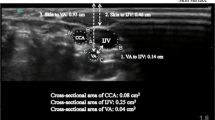Abstract
The objective of this study is to determine the best way to access and the position in which the patients must remain in order to obtain the best transversal section of the right internal jugular vein (RIJV) section during the catheterization by ultrasound, allowing a safer and precise access. The three possible ways to access the RIJV, anterior, lateral and posterior, from 57 healthy children, were examined by ultrasound in one similar sequence of positions: horizontal dorsal decubitus with the head centered in neutral position with and without the use of a pillow; horizontal dorsal decubitus with contralateral rotation of the head with and without the use of a pillow; horizontal dorsal decubitus with the head centered in neutral position and the patient in the Trendelenburg position without the use of a pillow. The relation between the different positions and punction regions in RIJV were established using analysis of variance. As a result, the lateral punction with the patient in the Trendelemburg position offered a largest area of the RIJV transversal section in comparison to all the other options (P < 0.0001). In conclusion, this study demonstrated that the safer and precise way for the RIJV catheterization in pediatric patients is obtained in Trendelenburg position with lateral access and without a pillow.






Similar content being viewed by others
References
Gordon AC, Saliken JC, Johns D et al (1998) US-guided puncture of the internal jugular vein: complications and anatomic considerations. J Vasc Interv Radiol 9:33–38. doi:10.1016/S1051-0443(98)70479-8
Defalque RJ (1974) Percutaneous catheterization of the internal jugular vein. Anesth Analg 53:116–121. doi:10.1213/00000539-197401000-00030
Lobato EB, Sulek CA, Moody RL (1999) Cross sectional area of the right and left internal jugular veins. J Cardiothorac Vasc Anesth 13:136–138. doi:10.1016/S1053-0770(99)90075-7
Botero M, White SN, Younginer JG (2001) Effects of trendelenburg position and positive intrathoracic pressure on internal jugular vein cross-sectional area in anesthitized children. J Clin Anesth 13:90–93. doi:10.1016/S0952-8180(01)00220-3
Mallory DL, Shawker T, Evans G et al (1990) Effects of clinical maneuvers on sonographicallly determined internal jugular vein size during venous cannulation. Crit Care Med 18:1269–1273. doi:10.1097/00003246-199011000-00017
Sulek CA, Gravenstein N, Blackshear RH et al (1996) Head rotation during internal jugular vein cannulation and the risk of carotid artery puncture. Anesth Analg 82:125–128. doi:10.1097/00000539-199601000-00022
Bazaral M, Harlan S (1981) Ultrassonographic anatomy of the internal jugular vein relevant to percutaneous cannulation. Crit Care Med 9:307–310. doi:10.1097/00003246-198104000-00004
Parry G (2004) Trendelenburg position, head elevation and a midline position optimize right internal jugular vein diameter. Can J Anaesth 51(4):379–381
Suarez T, Baerwald JP, Kraus C (2002) Central Venous Access: the effects of approach, position and head rotation on internal jugular vein cross-sectional area. Anesth Analg 95:1519–1524. doi:10.1097/00000539-200212000-00010
Verghese ST, McGill WA, Patel RI et al (1999) Ultrasound-guided internal jugular venous cannulation in infants. Anesthesiology 91:71–761. doi:10.1097/00000542-199907000-00013
Author information
Authors and Affiliations
Corresponding author
Additional information
The experiments comply with the current laws of the Brazilian legislation, country in which they were performed.
Rights and permissions
About this article
Cite this article
Ybarra, L.F., Ruiz, H., Silva, M.P. et al. Ultrasound evaluations of internal jugular vein punction techniques in children: the easiest method to reach the target area. Pediatr Surg Int 25, 99–104 (2009). https://doi.org/10.1007/s00383-008-2298-2
Accepted:
Published:
Issue Date:
DOI: https://doi.org/10.1007/s00383-008-2298-2




